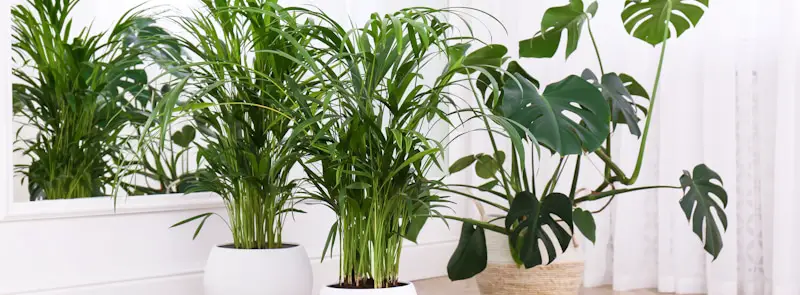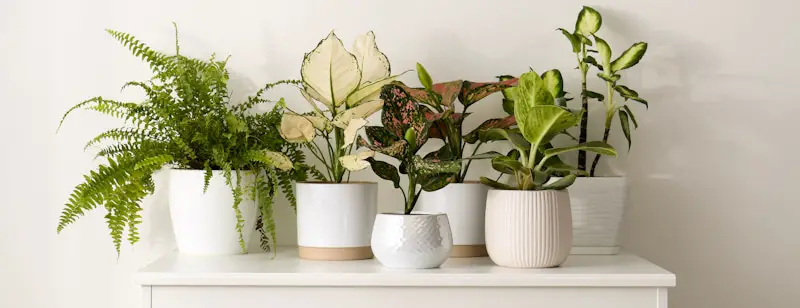Just like we need food to survive, plants need an adequate amount of sunlight to survive. Most of the houseplants we get are either from the forest floor or climbing along the trees. As a result, they get a lot of the sun, direct as well as filtered through the tree canopy.
Both types of natural lights are essential sources of nutrients for these little greens. Bright indirect sunlight is diffused light. It is the kind that replicates the sun so that your plant can keep photosynthesizing even when it is indoors. Bright indirect light is bright enough to cast a shadow. However, the shadow is usually blurry and indistinct.
If you have come across this term and do not fully understand its importance for your plant, then keep reading. In this article, we will discuss in detail what bright indirect light is, its importance, and the best places for it indoors for your plant.
Types of Lights
One thing that confuses most houseplant owners is the difference between direct and indirect light. Yet, understanding these two concepts is critical to comprehending bright, indirect light because it falls between them.
1. Direct Light
As the name suggests, it is the light that comes straight from the sun. Therefore, there is no hindrance between the plant and the sun. For instance, if you have placed your plant on the window sill, it will get direct sunlight. However, while natural sunlight is vital to plants, too much can be detrimental and cause the plants to dry out and wilt.
2. Indirect Light
It is when the sun rays are not hitting the plant directly. Instead, the light usually reflects off some surface. For example, you have placed a plant near a curtained window. The light that trespasses through the cloth and shines on the greens is known as indirect light. It does not have as much intensity as direct light, so it is preferred more than the other.
3. Bright Indirect Light
This type of light is the middle ground. It is bright, yet it is not direct. It is an ideal source for all greens indoors. For instance, if you place your plant on the coffee table in the living room and pull the curtains back from the windows. The room is undoubtedly illuminated. However, the sun is not burning your skin. So this kind of light is known as bright, indirect light.
You can quickly test it out by checking out the plant’s shadow. If you can see a blurry and faded shadow, your plant has the perfect bright indirect light. Another way of checking it is by placing your hand right behind the leaf or stem of the plant. Again, you should be able to make out a faint shadow.
How Do You Measure Bright Indirect Light?
There are two measures to determine if the intensity of the light is ideal and enough for your plant or not.
Shadow Technique
One of the most common ways is the shadow technique. If your plant makes a sharp, defined shadow, it receives direct sunlight. Contrarily, if the shadow is weak and blurry, it indicates indirect light.
However, you must ensure that your plant gets bright indirect light and not just low light. If the shadow is barely visible, your plant will probably get low light. So move it closer to the light source while keeping it out of the sun’s direct rays.
Use a Light Meter
If you are unsatisfied with the shadow method, purchase a light meter. It is a tool that measures the light’s intensity by foot candles, a unit of measure defined as one lumen per square foot. It is usually used to measure how bright the light is one foot away from the source.
Bright indirect light is approximately between 800-2000 foot candles. However, this varies depending upon many factors. For example, the time of the day, the meter’s direction, and the plant’s location can affect the measurement.
So, if you are planning to use a light meter, use the light meter reading with your understanding of bright indirect light. This way, you will be able to picture the light better your plant is receiving.

How Do You Make Bright, Indirect Light?
There are many ways to make bright, indirect light for your plants. All you have to do is use your windows smartly and keep an eye on the sun’s direction throughout the day. However, if you are looking for some examples or ideas of bright indirect light, then read down below.
We have divided the list into directions of your windows so that you can place your plant at the right angle and distance.
1. North
If you have a window facing north, it might seldom get direct sunlight. So, you can place your plants on the windowsill for the ideal bright, indirect light. While just putting them on the window sill is enough during summers, it would be better if you place a mirror on the opposite wall during winters. If the illumination is not enough, the mirror can reflect the light back to the plant. Another alternative is to purchase an LED grow light.
2. South
Windows on the south can get plenty of sun during the day. So if you are considering placing your plant near the window, put it approximately three to six feet away. You might even need to place them further away. However, this depends on how far the sun rays enter the window.
On the other hand, if trees or buildings shade the window, you can place your plant near the window. Also, keep the window closed if you put it on the sill. Just make sure that the plant is not receiving direct sunlight.
3. East
East-facing windows might receive direct sunlight early in the day and become milder as the day passes. So, you can quickly put the plant on the sill or near it without needing a filter or diffusing drape. The light will not be strong enough and will provide the perfect indirect illumination.
4. West
The afternoon sun can be scorching and might be too much for the plant. So, you need to place the plant at least three to five feet back from the windows or insert a diffusing drape between the plant and the window.
However, many other factors come into play. For example, time of the day, weather patterns, and seasons can affect the intensity of the light. Therefore, it is important that you know the local patterns of the day and seasons in your area. If it is harder for you to keep track, you can find many online mobile applications to track the sun’s movement and check the weather.
Final Words
When determining where to put your houseplant, it is essential to understand the intensity of sunlight throughout the day. For example, the sun rises in the east, so if you place your plant on an east-facing window, it might have intense sunlight early in the morning, which might diffuse during the day as the sun moves towards the west.
Moreover, make sure to measure the light intensity to check if the light is ideal for your plant. You can use a shadow technique or a light meter. Though, many experts believe you need to use both for the best estimation. Lastly, sunlight is one of the many nutrients a plant needs to survive. The environment’s temperature, water, soil, and humidity levels are also crucial for the plant. So, make sure to monitor these as well!
Victoria is the owner and main author of hobby plants. She loves spending her free time in her garden planting and taking care of her plants. Victoria hopes you enjoy the content here!
